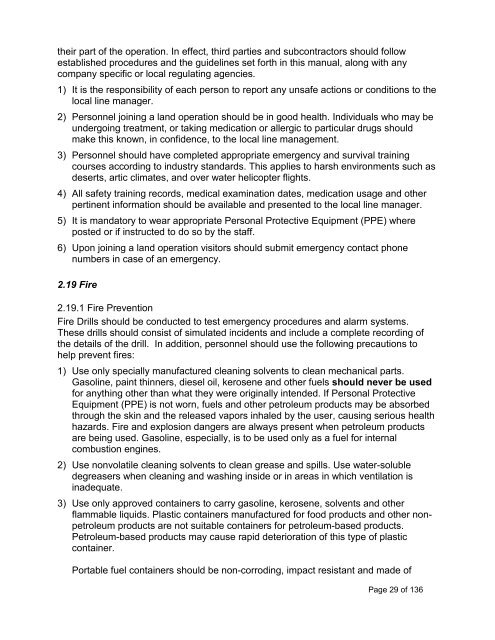IAGC LAND GEOPHYSICAL SAFETY MANUAL Edition 9 ... - CGISS
IAGC LAND GEOPHYSICAL SAFETY MANUAL Edition 9 ... - CGISS
IAGC LAND GEOPHYSICAL SAFETY MANUAL Edition 9 ... - CGISS
- No tags were found...
You also want an ePaper? Increase the reach of your titles
YUMPU automatically turns print PDFs into web optimized ePapers that Google loves.
their part of the operation. In effect, third parties and subcontractors should followestablished procedures and the guidelines set forth in this manual, along with anycompany specific or local regulating agencies.1) It is the responsibility of each person to report any unsafe actions or conditions to thelocal line manager.2) Personnel joining a land operation should be in good health. Individuals who may beundergoing treatment, or taking medication or allergic to particular drugs shouldmake this known, in confidence, to the local line management.3) Personnel should have completed appropriate emergency and survival trainingcourses according to industry standards. This applies to harsh environments such asdeserts, artic climates, and over water helicopter flights.4) All safety training records, medical examination dates, medication usage and otherpertinent information should be available and presented to the local line manager.5) It is mandatory to wear appropriate Personal Protective Equipment (PPE) whereposted or if instructed to do so by the staff.6) Upon joining a land operation visitors should submit emergency contact phonenumbers in case of an emergency.2.19 Fire2.19.1 Fire PreventionFire Drills should be conducted to test emergency procedures and alarm systems.These drills should consist of simulated incidents and include a complete recording ofthe details of the drill. In addition, personnel should use the following precautions tohelp prevent fires:1) Use only specially manufactured cleaning solvents to clean mechanical parts.Gasoline, paint thinners, diesel oil, kerosene and other fuels should never be usedfor anything other than what they were originally intended. If Personal ProtectiveEquipment (PPE) is not worn, fuels and other petroleum products may be absorbedthrough the skin and the released vapors inhaled by the user, causing serious healthhazards. Fire and explosion dangers are always present when petroleum productsare being used. Gasoline, especially, is to be used only as a fuel for internalcombustion engines.2) Use nonvolatile cleaning solvents to clean grease and spills. Use water-solubledegreasers when cleaning and washing inside or in areas in which ventilation isinadequate.3) Use only approved containers to carry gasoline, kerosene, solvents and otherflammable liquids. Plastic containers manufactured for food products and other nonpetroleumproducts are not suitable containers for petroleum-based products.Petroleum-based products may cause rapid deterioration of this type of plasticcontainer.Portable fuel containers should be non-corroding, impact resistant and made ofPage 29 of 136
















